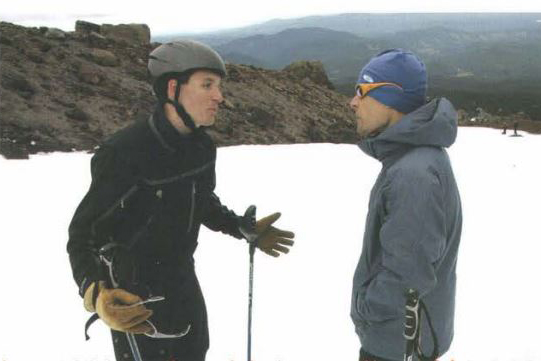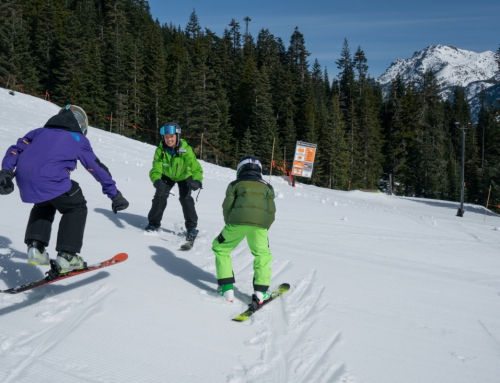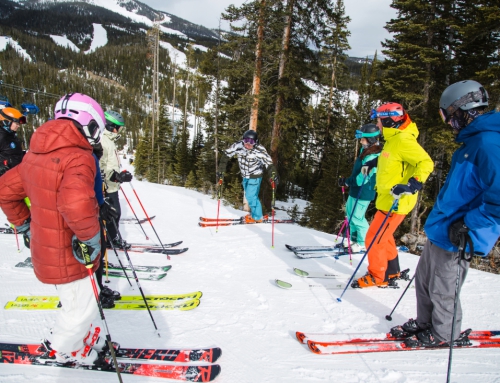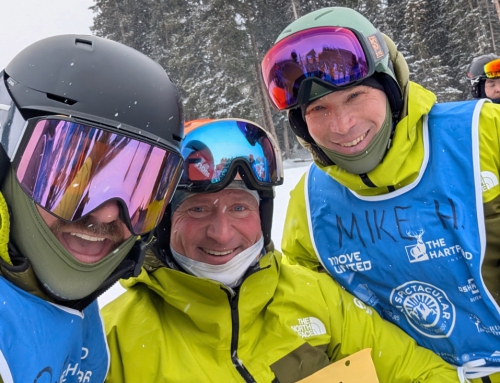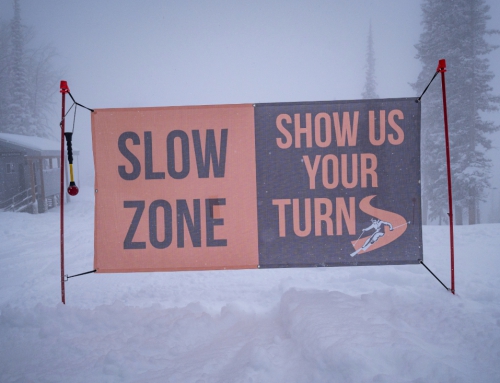Celebrating some of snowsport’s instruction’s most timeless article, this article by Lane McLaughlin is from the Spring 2008 issue of The Professional Skier, the predecessor to 32 Degrees magazine.
Perfect Alignment: When Wants Join Forces with Needs
WHAT MAKES FOR A PERFECT LESSON?
As an instructor, I envision a scene in which students are willing to try anything my coaching imagination can come up with, and each exercise and suggestion leads immediately to success, learning, and fun.
Our students, however, might have a different take. To them, perfection might simply be exploring an unfamiliar mountain with a local who knows where all the best powder stashes are.
Our students, however, might have a different take. To them, perfection might simply be exploring an unfamiliar mountain with a local who knows where all the best powder stashes are.
The fact is, each lesson is a unique experience with its own measure of success, both from the student’s and instructor’s point of view. It’s not uncom- mon for students to have a wide variety of expectations-reflective of individual wants-while our coaching instincts, training, and actions drive us to focus on student needs. Ultimately, the success of any given snowsports lesson hinges on how well we are able to align those wants and needs, making them complimentary focal points rather than conflicting forces.
When we approach needs as a way to deliver on what students want, we’re that much closer to teaching the perfect lesson.
WHAT IS A WANT?
A want is something you’d like to have, but at a fundamental level is optional. We can survive without it but there’s some craving, motivation, or perception that having our want fulfilled will allow us to prosper, succeed, or enjoy what we do that much more. I’m sure you’ve heard your guests express a wide variety of wants-from fun to funky, detailed to open-ended. The most common ones probably sound something like:
- “I want to handle the steeps better.”
- “I want to have fun.”
- “I want to be in better balance.”
- “I want to catch huge air on some jumps.”
- “I want some tips to figure out this new equipment.”
- “I want to learn something today. “
- “I want to keep up with my kids.”
I definitely hope that students come to my lessons loaded with wants. In fact, I’d like to revise my introductory scenario of the “perfect lesson” to add that the students come to the lesson with high hopes and specific expecta- tions, openly communicate their wants, and trust me to guide them to the out- come. I want them to want. While it’s challenging to satisfy specific expecta- tions and desires, it’s incredibly reward- ing. And besides, that’s what we’re there for.
Wants can be powerful motivators, largely because some very positive emotions are associated with them (fig. 1). After all, a want can be related to any one or a combination of the following:
- Passion-the students have a strong belief that if they get what they want they’ll be satisfied or their experi- ence will be enhanced.
- Vision-the students have a very positive picture of success.
- Hope-the students assume the desired outcome is possible.
- Fantasy-the students anticipate a fun, playful, entertaining, and magical experience with no negative consequences or limitations.
- Reward-the students expect to realize a gain, i.e., the payoff will exceed the effort.
Because wants are often centered on emotion, achievement, and positive ex- pectations, they can be somewhat fragile. The last thing you want to do when
someone professes a desire to achieve a positive outcome is to cast that want as being beyond the realm of possibility. Another surefire way to “crush a want” is to make it solely contingent on a need the students didn’t even know they had. For more on this, see the section titled “Avoid Being the Want-Crusher.”
WHAT IS A NEED?
In contrast to a want, a need is some thing you have to have. Needs are not optional; they’re essential for survival. In the context of ski and snowboard teaching, I think of “survival” as the student’s continuing motivation to engage, participate , and continue in the lesson process. Once that motivation is lost, the learning process usually stops dead in its tracks.
Compared to the endless variety of wants people may have in a les- son, the list of survival needs is quite small and universal. As you’ll recall from Abraham Maslow’s “Hierarchy of Needs” (see PSIA’s Core Concepts manual, page 35), people are driven by motivational needs that fall within the following categories:
- Physiological-having food, water, shelter, and clothing
- Security-sensing protection, a safe environment, and reasonable risks
- Belonging-giving and receiving friendship, love, and appreciation
- Esteem-attaining recognition, attention, competence, and mastery
- Selfactualization-achieving growth and meeting one’s potential
As you move down the list, each becomes a more complex need (or set of needs), can only be satisfied if the previous needs are met, and is more difficult for the instructor to have control or influ- ence over. Therefore, before you set off into lesson plans, progressions, drills, and feedback, take stock of the non- negotiable items you must address to promote a successful lesson experience. Perhaps it boils down to these basics:
Focus on biology-keep students fed, move enough to stay warm, break often enough to recover, and respect when nature calls (i.e., plan on potty breaks).
- Focus on safety-select the appropriate level of challenge, manage and mitigate risks, and demonstrate the Responsibility Code through your own actions.
- Focus on the group-develop a respectful and trusting environment in which all individuals fit into
the whole and know they won’t be embarrassed or humiliated. - Focus on the individual-listen to, observe, coach, and praise each person.
- Reflect on the experience-use the quality of the experience and time spent together; sharing the pursuit of wants as a measure of success more than a specific outcome.
- ALIGNING WANTS AND NEEDS
Because expectations are so personal, it may be hard, especially when your class mix is a group of strangers, to get individuals to share aloud or even speak one-on-one with you about what they truly want. That said, the overall lesson experience and your relationship with students depends upon being willing to solicit-and listen to-student input, rather than assume what they want, or worse, push upon them what you think they should want. By listening carefully for what your students want to learn in the lesson, you grow from simple coach to the guide or guru who will help them exceed their own expectations.
- In your lesson introductions you likely create a dialogue that’s intended to draw wants from your students and facilitate the goal-setting for the lesson. Perhaps you even ask the patented ques- tion, “Where do you want to go today?” I’m willing to bet you dorit always get an outpouring of enthusiastic or concrete wants flowing from your group.
On the flip side, other people and groups respond with an avalanche of ideas that, considering where their cur- rent skills lie, may be borderline fantasy. When lesson success is predicated on helping people with what they want, how should you respond to silence, indifference, or even over exuberance and unrealistic expectations? Let’s examine each and come up with positive strategies all the way around.
GIVE A LIFT TO THE ‘WANT-LESS’
Perhaps it’s nerves, shyness, confusion, fear, boredom, or passiveness that’s blocking your students from telling you what they want. Since it’s probably early in your lesson, and your acquaintance with your group (and them with each other) has yet to gel, it’s common for people to hold back a little bit.
In fact, upon applying Maslow’s Hierarchy of Needs you might find that there are a variety of physical, emotional, or social needs among group members that need to be addressed before your students tell you what they want. One person may admit that he’s scared or had a bad experience in a lesson last week. Another may be cranky because she missed breakfast or because her best friend got put in another group even though they thought they’d be together. Maybe one student is miser- able because his left big toe really hurts in his new boots. The point is, none of these students can focus on “where they want to go” when something is botherng them to the extent that they don’t want to be where they are right now.
The key for you, the instructor, is to be very patient with the goal-setting pro- cess and prioritize the “people” process. If your group kicks off the session a little too shy to open up to you, or a bit indiffer- ent to learning something specific, focus your initial activities on simply warming your group up. I’m referring here not to a physical warm-up but a social warm-up, in which they begin to build their trust in you as a leader and a friend. They’ll also establish some familiarity and trust with the others in the group.
For example, if I have a group lesson where the goal is not obvious from
the onset, I’ll ask permission from the group to take a couple of runs to get our bodies moving and assess the conditions before we jump into things. I look and listen to their response, checking for buy-in and perhaps even a sense of relief from people who are nervous about having their skiing critiqued. A couple of runs usually provides enough time for me to get around to everyone- whether it’s during some quad-chair discussions or at some stopping points on the run-and solicit individual goals while looking for a possible common thread to these goals that would suggest a group theme. This warm-up time is well spent if you can make a connection with each person and them with their peers.
Then you can segue to asking a variety of questions and making sug- gestions that get your group thinking about the possibilities for the session. Ask them questions like:
- “What are the biggest challenges with today’s conditions?”
- “Today would be successful if you could [encourage them to fill in the blank].”
- ”Are there any plateaus you’re looking to break through today?”
- “What’s the most exciting aspect of today’s conditions?”
Offer suggestions and sell the possibili- ties, such as:
- ”Are you all open to trying?”
[Now it’s your turn to fill in the blank.]
- “I love today’s conditions and how they let me _ _ _ [cite something fun]. Can I show you what I’m talking about?”
- “It’s very common at this stage of skiing to struggle with _ _ _ _ [cite something notorious]. Would I be a hero if I could help you beat that today?”
These are the kind of starter questions and suggestions that serve as the kindling. There will be situations in which students feel as though they hired you as the “expert” and they simply want you to take charge and dazzle them with your best stuff. Therefore, while I stress being patient and developing the rapport needed to glean from students what they want, also be aware of signs-such as fidgeting and eager glances down the hill-that the group would like you to stop asking questions and just start skiing.
AVOID BEING THE ‘WANT CRUSHER’
If you do get a flood of wants from your class, what do you do with all that information? Because of your experience, knowledge, and willingness to be a problem solver, you might come to quick conclusions (maybe even assumptions) about what is realistic and pos- sible relative to the group’s wants. Ifyou fail to acknowledge and embrace student wants-shifting too quickly into express- ing what they need-you may innocently “buzz-kilY’ those wants. While wants can
to the dialog you’ll have with your group, which will hopefully uncover something ofinterest and inspiration. These phrases are open-ended enough to show your group that (1) you care about them, (2) they have a say in the process, and (3) the lesson is not a canned product. This line of conversation also shows that you’re a pro and in the know ofwhat’s fun, what’s hard, what’s possible and, therefore, what’s worth the price of admission.
You’ll be surprised how quickly stu- dents can go from being unsure to being intrigued. You’ll see it in their body language or maybe even in the fervor with which they take on a task. The turning point may be a question you ask, an idea you suggest, a conversation they have with another student, or something you all witness on the hill that entertains or inspires them. It might even be when their coffee kicks in. Or maybe, just maybe, they’ll engage in the lesson when they see you ski and think, “Hey, I want to ski like that!” be ambitious, needs may dwell on those “boring details” that bring people back to earth or reset expectations.
A want-crushing instructor address- ing the possible expectations listed at the beginning of this article might be overheard giving the following kinds of responses:
- “If you want to handle the steeps better, you need to spend more time on the flats.”
- “If you want to be in better balance, you need to get better boots.”
- “Before I let you catch huge air, you need to learn some speed control.”
- “If you want to learn something here today, you need to pay more attention.”
- “If you want that new equipment to work better for you, you need to change your stance.”
- “You don’t need to keep up with your kids, you just need to work on efficiency.”
These statements are exaggerated examples of how a want-versus-need assessment can be antagonizing. But even a subtle approach to addressing student wants and needs can sour peo- ple’s appetites for lessons. Why? Because when you say “If you want that, you need to do this” the students’ fantasy bubble bursts before it even gets a chance to float. They may realize, with a certain amount of resignation, that rewards will come only with an investment of more effort, time, practice, and lessons than they expected. Some, perceiving that you’re calling out their deficiencies, may lose self esteem and confidence. Others might think that rather than listen to their goals, you’re asserting yourself as the ultimate authority on what the goal should be.

